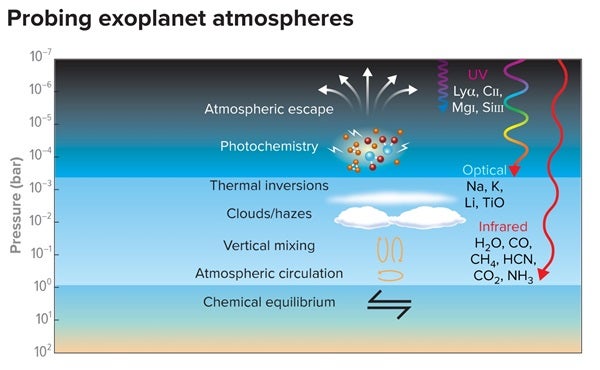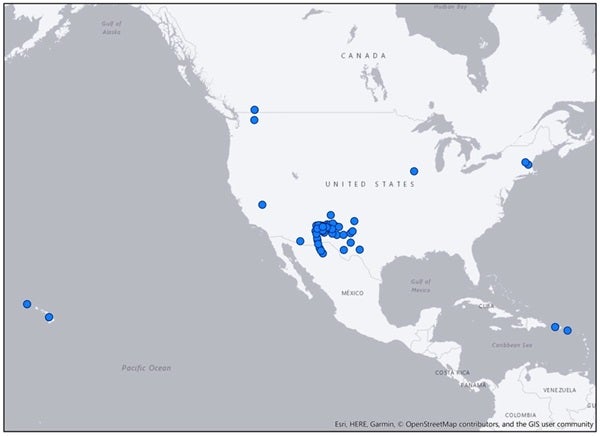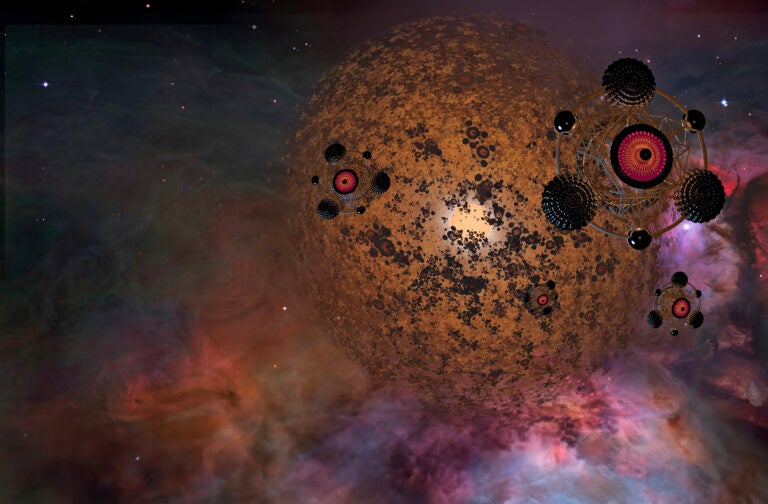Estimating the chance of getting a message from life beyond Earth, say within the next decade, isn’t easy. Even the best experts are reluctant to offer precise odds.
“Anybody who gave you a figure would be talking about religion, not science,” says Jill Tarter, the astronomer who has spent most of her life pursuing the quest to find signals from alien life.
And even if you did get an estimate for that probability, it wouldn’t mean much. (After all, the San Francisco 49ers had a 95 percent chance of winning the Super Bowl with under 8 minutes to go in the game — and still lost.)
But however small the probability of seeing a signal from E.T. is, those chances are soon going to be a lot better than they have been in the past.

Untangle the mysteries of our solar system’s planets and moons. Check out Astronomy’s free downloadable eBook, The Hitchhiker’s Guide to Planets, which contains everything you need to know about our solar systems major players.
Sure, after decades of listening, there is still no message. But with more data to sift through, and new technologies with superior search capabilities, odds of hearing from E.T. are rapidly improving. If the probability in the decade 2011–2021 were x percent, it’s going to be 1,000 times x in the following decade, says Andrew Siemion, director of the Berkeley SETI Research Center. (SETI stands for Search for Extra-Terrestrial Intelligence.)
The reason for E.T. optimism stems largely from several new projects in the works, enhanced with advanced methods for discerning an actual message hidden in the static of cosmic cacophony.
Siemion, speaking in Seattle on February 15 at the annual meeting of the American Association for the Advancement of Science, reported a new release of data from Breakthrough Listen, a major enterprise for recording radio signals from space. Now available for others to analyze, the data dump contains 2 petabytes of information (to store that much, you’d need 2,000 of today’s typical PCs with their puny 1 terabyte hard drives).
Tarter, chair emeritus for SETI Research at the pioneering SETI Institute, described new search projects in the works at the institute, including Laser SETI. It’s a plan to train 96 cameras at a dozen locations around the world to keep a constant vigil for “intelligent” optical signals from space.
Another key driver of increased optimism is the abundance of places to look for life. Thanks largely to the Kepler space telescope’s successful explorations, astronomers now know of thousands of stars possessing planets — and have spotted dozens of rocky, Earth-like planets orbiting their stars at a distance likely to be temperate enough for liquid water, a hopeful indicator of habitability.
And of course, it is still possible that alien life might be hiding closer to home. While it’s very unlikely that any intelligent life abides in our solar system, microbial biology might be viable on moons such as Enceladus (Saturn) and Europa (Jupiter). Robots equipped with tools to extract microorganisms from alien soil and conduct chemical analysis could search for life on site. In the meantime, land- or space-based telescopes might detect signs of biological activity in the atmosphere of distant planets. Certain combinations of molecules in the right ratio would be surefire signatures of life in action.
“The ultimate breakthrough in exoplanetary science will be the detection of a biosignature in the atmosphere of a rocky habitable-zone exoplanet,” astronomer Nikku Madhusudhan noted last year in the Annual Review of Astronomy and Astrophysics. “Defining a unique biosignature remains a theoretical challenge, but several candidate molecules have been suggested.”
No one molecule (not even oxygen) would be a definite sign of life. But multiple life-related molecules detected in the atmosphere of a planet with other suitable conditions (such as a comfy temperature) would be strong evidence. Under Earth-like conditions, various molecules, such as oxygen, ozone, methane, carbon dioxide, nitrous oxide and ammonia could be taken as indicators of biological activity.
“Though there is no single ideal molecule, the combination of multiple species (e.g., oxygen and methane) may be a potential biosignature under the given conditions,” wrote Madhusudhan, of the University of Cambridge in England. “In this regard, a detection of oxygen and methane and/or nitrous oxide along with liquid water on a habitable-zone planet, i.e., an almost exact Earth analog, may be a sure sign of life.”
Seeking techno-signals
Finding primitive extraterrestrial life would be front-page news (or set a record for clicks), but the grand prize is reserved for the “I” in SETI — intelligent life. SETI searches seek signs of technology produced by extraterrestrial intelligence, most likely in the form of “unnatural” radio waves.
In fact, an alien looking for life in the cosmos might very well spot Earth as inhabited by exactly that method. In the 1990s, Carl Sagan and colleagues took advantage of the Galileo spacecraft’s pass by Earth to probe our planet for telltale signals of our existence. The giveaway was narrow-band radio emissions (abundant signaling at a single radio frequency).
“That as far as we know is an unmistakable indicator of technology, and an unmistakable indicator of life,” Siemion said at the AAAS meeting. “And indeed it is the most detectable signature of life on this planet as viewed from a distant vantage point.”
For now, Earth-based radio telescopes listening to the cosmos might hear a deliberate message, but couldn’t pick up TV shows or other radio-wave “leakage” from alien civilizations. But the Next Generation Very Large Array, now in the planning stage, would have the power to receive such unintentional communication, at least from nearby stars.
Perhaps alien civilizations may make more use of lasers than radio, though, which makes the prospect of Laser SETI appealing. But whether patterns are found in the radio or optical region of the electromagnetic spectrum doesn’t matter — such patterns could reveal intelligent activity regardless of their purpose, Siemion pointed out.
“We simply look for compression of electromagnetic energy in time or in frequency or some kind of modulation that is inconsistent with the astrophysical background or the instrumental background and consistent with something that technology could produce,” he said. “So it doesn’t matter if it’s a laser communication system being used to communicate with a spacecraft in some exoplanet system or it’s a giant laser light show that some very advanced civilization produced for the amusement of all the life in their system.”
In any event, receiving a message would be a monumental revelation about the viability of technological civilizations. Nobody knows whether a society that has developed advanced technology can long survive.
“The lifetime of a technological civilization … is a very difficult thing to predict,” said Siemion. “And of course, looking around at our own civilization you have reason to question what that term might be.”
On the other hand, a signal from space would almost certainly be from a civilization that has existed much longer than ours. (Otherwise the likelihood of listening in at exactly the right time would be prohibitively small.) So merely receiving a message might be considered hope that civilization on Earth might not be doomed after all.
Success in receiving a message raises other issues. For one thing, it’s a real possibility that an alien message is clearly an attempt to communicate, but in a language that no earthling could understand. And understood or not, a message received suggests the need to consider a reply. SETI researchers have long agreed that if a signal is detected, no response would be made until a global consensus had been reached on who will speak for Earth and what they would say. But that agreement is totally unenforceable, Tarter pointed out, and nobody has any idea about how to reach a global consensus on anything. (Perhaps the proper reply would just be “HELP!”)
Still, contemplating a response is for the moment a lesser priority than finding a message in the first place. And that might require help from nonhuman intelligence right here on Earth in the form of advanced computers. Recent developments in artificial intelligence research should soon make machine learning an effective tool in the E.T. search, Tarter said at the AAAS meeting.
“The ability to use machine learning to help us find signals in noise I think is really exciting,” she said. “Historically we’ve asked a machine to tell us if a particular pattern in frequency and time could be found. But now we’re on the brink of being able to say to the machine, ‘Are there any patterns in there?’”
So it’s possible that an artificially intelligent computer might be the first earthling to discern a message from an extraterrestrial. But then we would have to wonder, would a smart machine detecting a message bother to tell us? That might depend on whom (or what) the message was from.
“I think there’s something particularly romantic,” said Siemion, “about the idea of machine learning and artificial intelligence looking for extraterrestrial intelligence which itself might be artificially intelligent.”
10.1146/knowable-030220-1
This article originally appeared in Knowable Magazine, an independent journalistic endeavor from Annual Reviews. Sign up for the newsletter.












